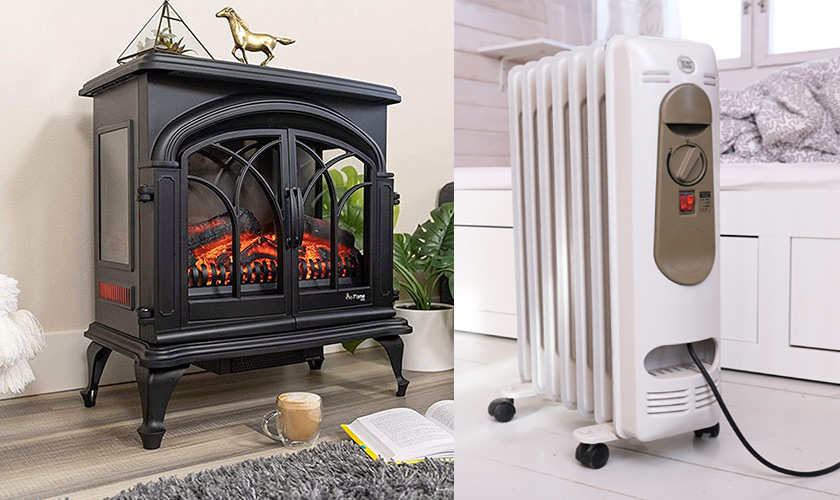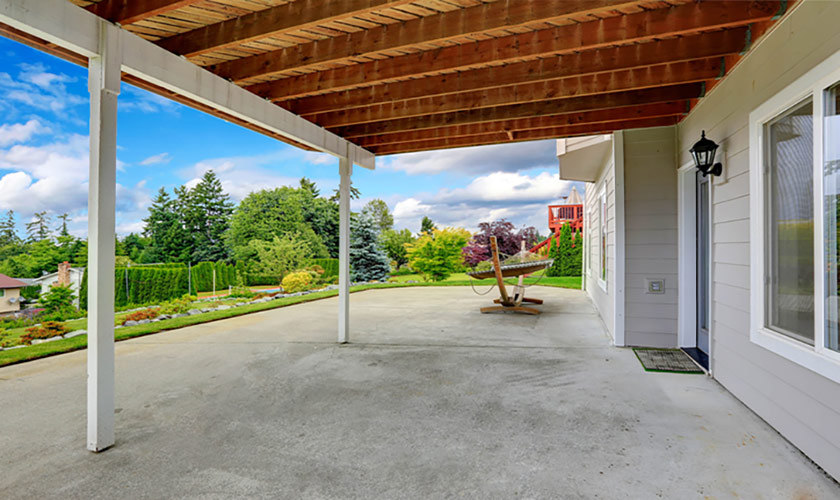
Regarding patio heaters, there are two main types: electric and propane. Electric vs propane patio heaters have pros and cons, but which is best for you? Here’s a breakdown of the differences between electric and propane patio heaters.
The general belief is that an electric patio heater is better than a propane patio heater. You can use an electric heater indoors and outdoors because it doesn’t emit harmful gasses and is more environmentally friendly. Propane heaters are more expensive because you have to keep refilling them, and they can emit harmful emissions in enclosed areas.
However, this doesn’t mean that the electric patio heater is your best choice. If you want to keep a large area warm, it is better to use a propane heater. Also, a propane heater can raise the temperature much more than an electric one.
Overall, they are both excellent choices, but which is right for you? Well, let’s find out down below!
Electric vs Propane Patio Heater: Which is Better?
Whether you should choose an electric patio heater or a propane patio heater depends on your situation.
Electric Heaters
An electric patio heater is better if you have children running around because they are cool to touch.
They can be used indoors and outdoors, making them an excellent choice for patios enclosed with screening or glass.
It is also a good idea to choose an electric patio heater if you have an umbrella covering your seating area. If you have furniture that is not mobile, it is better to use an electric patio heater because you won’t mind that it isn’t portable. An electric patio heater is a much safer option when installing a heater closer to other furniture or fixtures.
Propane Heaters
However, if you want a more portable patio heater, a propane patio heater is a better option for you. This heater type is also better if you don’t have a power outlet near where you want to place it.
By choosing a propane heater, you will get more flexibility to place it because it is portable. Propane patio heaters provide more heat than electric patio heaters.
It would be best to remember that propane patio heaters are more expensive because you have to keep refilling them.
They can only be used outside, and there is a possibility that they might leak. Propane patio heaters are less environmentally friendly and less safe for children and pets. Insects and bugs nest inside propane patio heaters if you don’t cover them.
Differences Between Electric & Propane Heaters
Safety
Portability
User-friendly
Heat Output
Cost

How Do Electric Patio Heaters Work?
Electric patio heaters work by converting electricity into infrared heat through a lamp or heating element. Electromagnetic waves then transmit the heat through the air until it reaches a person or an object.
Electric patio heaters only heat objects and people; they do not heat air. Electric patio heaters work similarly to the sun, but there aren’t any harmful side effects like UV rays since the intensity is much lower.
You May Need Professional Help Depending
You can find electric patio heaters in portable and mountable styles. Most electric patio heaters need a higher voltage to produce more heat at once, but you can plug some heaters into a standard 120-volt wall socket. If you get a heater that needs a higher voltage, you will have to hire a professional to set up the wiring.
You might have a special place in your mind where you want to place your heater, but you will have to check the manufacturer’s manual first to determine the minimum clearance requirements.
When you know the minimum clearance requirements, you can find the best location for your electric heater. Make sure you always maintain those clearances for safety reasons.
Energy Efficiency
If the most important thing for you regarding heaters is their efficiency, look no further. Electric heaters are the most efficient type of heaters you can find.
They can convert roughly 98% of energy into heat using radiant heat. Radiant heat is a method of heat transfer. The heat is transferred directly to the person without spending energy heating the air. The heat your electrical heater produces won’t get blown away by the wind.
Most free-standing patio heaters heat in a circular region. Electric heaters mounted to a wall or a ceiling use the heat to warm a specific area directly.
Some mountable electric heaters will come with adjustable brackets that allow you to move the heat around as you please. These mounted heaters distribute the heat outward in the shape of a cone. Adding a few electrical heaters to your patio will provide evenly distributed heat.
Control Options
Electric patio heaters have many available control options. You can use a simple on and off switch, or, if you have a smart home, you can choose a complex system that you can integrate into it.
Most of these controls get produced by specific brands, so you should research those brands and see which one you like best. The most common options are on/off switch, variable control, handheld remote, timer, and smart home integration.
1. On & Off Switch
An on/off switch is the cheapest way to turn your electric patio heater on and off. You will have to install this switch on a wall or mount it on a surface.
2. Stacked Switch
If you have two heaters, you can install a stacked switch to control each electric heater independently. You can choose a half-power or a full-power operation.
Variable control is excellent for people who like to adjust and control their electric patio heater’s intensity. These controls include dimmers and timers. They also allow you to choose intervals to maintain a specific temperature.
3. Handheld Remotes
A handheld remote is a remote that allows you to control your electric heater wirelessly. There are simple remotes that only turn your heater on or off, and there are remotes with dimmers and a few transmission channels.
You can program these channels to fit all your needs. This remote lets you control more than just one electric heater.
4. Timers
Timers set how long the heater will be on. You can install them with other control systems.
Smart home heating controls are controls that you can connect to your smart home system allowing you to program different heating options and save the settings you usually use. You can control the heaters even when you’re not home with your phone.
5. Control Boxes
You can group your heaters into special heating zones. These zones will let you know how much heat one or all heaters emit in that area.
You will have to wire these electric heaters to a specified control box. You will control them with a handheld remote, or a control panel mounted to a wall.
Zone heating is excellent if you have a big property or more patios. You can control each of these zones separately, which lets you quickly achieve and maintain the desired temperature in every one of them.
Measured In Watts
While most heaters have their heating power measured in BTUs, an electric heater measures in watts. To calculate how many watts you will need to heat your space, you must multiply cubic feet of area with your desired temperature rise.
You might want to determine how much an electric heater will cost per hour before you buy it. You will first have to choose the maximum amount of watts your electric heater uses and your local rate for a kilowatt-hour. You can find the watts on the heater or in the manufacturer’s manual.
To find out what your local kilowatt-per-hour is, check the rate on your monthly utility bill. You will then divide the total watts by 1000 and multiply it by the kilowatt-per-hour rate from your utility bill. If you want to get the daily cost, you will have to pay cents per hour based on how many hours your heater will work each day.
You Can Use Electric Patio Heaters Indoors & Outdoors
You can use electric patio heaters indoors as well as outdoors. This is because they don’t need any ventilation. Electric patio heaters don’t emit any greenhouse gasses or produce carbon emissions. That’s why choosing an electric patio heater is an environmentally friendly choice.
Be careful when using your electric patio heater because it can get scalding. Make sure you buy an electric patio heater that has been UL-approved and CSA tested.
The tested and approved heaters are guaranteed to have undergone rigorous testing to ensure they are safe and reliable.
Inspect It Yearly
Every year, you will have to inspect your electric patio heater to ensure that your patio functions correctly and that nothing damages the wires.
Always turn off your electric patio heater before cleaning it and wait for it to cool down. Make sure you only clean the outside surface of the heater and never take it apart. You can find cleaning guidelines in your owner’s manual.

How Do Propane Patio Heaters Work?
Propane patio heaters work by burning gas. They emit radiant heat, which doesn’t heat the air but travels through air until it reaches a person or an object and keeps it warm.
Propane patio heaters will tell you how big a space they cover and how many BTUs they have. You will choose a propane patio heater depending on your patio’s size and how warm you want to keep it.
Propane provides about 2,500 BTUs per standard cubic foot, making it an incredibly efficient fuel source. Usually, a full-size propane patio heater will output 40,000 BTUs, and the heat will be distributed to an area about 20′ in diameter.
If your patio gets exposed to the wind, getting wind protection would be a good idea to protect the deck patio from cooling off.
Propane heaters are efficient because you can use them anywhere without needing gas or an electrical hookup.
Cost of Propane Patio Heaters
When propane heaters were first invented, they were costly. Only restaurants and commercial venues could afford them.
As the demand for propane heaters increased, the manufacturers started to produce cheaper ones. Today, propane heaters are very affordable, and you can get them in any garden center or home improvement center.
Propane patio heaters are the most expensive ones to use—their price measures per gallon. Usually, a propane patio heater can store about 4.7 gallons of fuel in its 20lb propane tank.
This tank can last about 10 hours, costing between $10 and $20 to fill up, making the average cost of using a propane patio heater between $1.50 and $2.00 per hour.
Two Types of Ignitions
You can choose between two types of ignitions for propane patio heaters – manual and automatic ignitions. If you select a manual ignition, you must choose a control now to control gas flow to your propane patio heater.
1. Manual Ignition
Some of these manual ignitions will have a push button, creating a spark that causes the gas to light. Some other manual ignitions will have a pilot light, which you will have to light manually.
2. Automatic Ignition
Propane heaters with automatic ignitions use electricity to ignite and control the gas flow. You can manage these heaters with a switch or a handheld remote. All mounted heaters use an automatic ignition system.
Two Versions of Propane Patio Heaters
There are two types of propane patio heaters: free-standing and tabletop propane patio heaters. You must consider some things when deciding which one is better for you.
1. Free-standing Heater
Free-standing propane patio heaters are the most common. They provide much more flexibility in finish and design.
If you want to keep a more significant area warm, or if you want your guests to be able to gather around your heater and stay warm, you should pick the free-standing propane patio heater.
2. Table-top Heater
On the other hand, many people opt out of using tabletop heaters because it provides less heat. Tabletop propane heaters are also more expensive than free-standing patio heaters.
You should get a tabletop propane heater if you only want to heat a small space, for example, an outdoor dining area or an end table. Tabletop propane heaters are much easier to move and are more portable than free-standing propane patio heaters.
Built-in Safety
Whatever type you choose will have a built-in safety system. This system shuts off the gas flow to the propane heaters if the flame goes out and can’t reignite again.
Make sure you read the owner’s manual before you decide where to place your propane heater. You can only use propane heaters outside, where a lot of airflows.
Inspect for Damage
Before using your propane heater, inspect it for any damage and check all gas connections, fittings, hoses, and lines.
Remember to turn off the control knob when finished using the propane heater. You should also disconnect the propane tank and store the heater upright, where it won’t be exposed to the weather.
It would be best to keep propane tanks outside in a cool, dark, well-ventilated area. If you have spare propane tanks, keep them a minimum of 20 feet away from any other patio heaters that are on to prevent possible fire or explosion.
Pressure Regulators are Useful
As the temperatures get colder, the molecules in propane slow down, causing the pressure inside your tank to drop when it’s cold outside. To keep your propane patio heater working correctly, equip it with a pressure regulator.
Watch Out for Gas Leakage
It would be best if you always looked for any leaking gas. Naturally, propane gas is odorless. That is why manufacturers add a distinct smell to it so that you can detect any leakage. This scent is powerful and unpleasant, and it smells kind of like rotten eggs.
Soap Test
If you think there is a leak, but you can’t smell it, don’t turn on the heater. You should, instead, make a soap solution. Mix equal parts liquid of soap and water and apply that soapy water to the gas connections with a spray bottle. Look closely at the gas connection.
If you notice any bubbles, there is a leak. You will then have to turn off the gas supply and tighten the leaking fittings. Follow the owner’s manual to repair the leak.
Inspect Your Heater Before Each Use
Propane patio heaters are very easy to maintain. However, you will have to inspect your heater before every use to ensure everything is properly working.
It is a good idea to cover your propane heater when you’re not using it to protect it from minor bugs and insects. They tend to nest in propane heaters when you’re not using them.
Make sure you always turn the gas off before cleaning your propane patio heater. You can only clean it on the outside and don’t take it apart. Always check the owner’s manual before cleaning. You will find how and how often you should clean your heater.
Electric vs Propane Patio Heater FAQs
Are electric or propane patio heaters better?
Electric patio heaters have a higher installation cost (except for portable models) than propane patio heaters. Electric patio heaters are efficient because they heat objects and do not emit harmful gasses. Propane patio heaters heat the air and can be affected by wind.
Are electric patio heaters as good as gas?
In many ways, electric patio heaters are better than gas patio heaters. The main difference is that electric heaters emit infrared rays that heat objects and are not affected by wind. Electric heaters require a higher upfront cost because the heaters need to be installed by a qualified electrician.
Are electric patio heaters worth it?
Electric patio heaters are worth it. However, you need to ensure the heater you purchase matches the coverage area you need. Electric patio heaters do not heat the air they heat objects. Therefore, the electric heater should be installed at the proper height and pointed in the direction where people will gather.
How long does a 20lb propane tank last on a patio heater?
A 20lb propane tank will last approximately 6-8 hours on a patio heater. This will vary depending on the size and power of the patio heater.
Are patio heaters safe on decks?
Yes, patio heaters are safe on decks. However, following all safety instructions with your patio heater is important. Additionally, you should always keep propane patio heaters away from flammable materials. Electric patio heaters do not have a flame.
How much does it cost to operate patio heaters?
Electric patio heaters are typically less expensive to operate than gas patio heaters. However, the cost of operation will vary depending on the specific model of patio heater and the price of electricity in your area.









